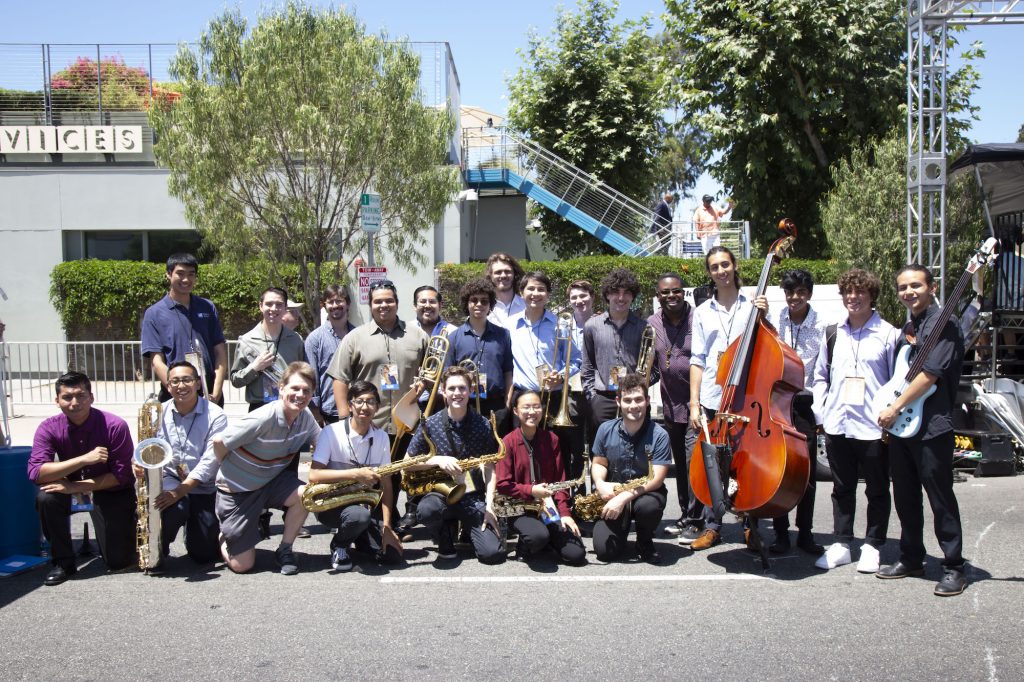The following is an excerpt from the article “Road Rules: Tour Etiquette for Young Musicians” by Institute Vice President, Education and Curriculum Development Dr. JB Dyas, which appears in the October 2019 issue of DownBeat Magazine.
Touring can be an exhilarating and rewarding experience–if you are prepared for it. But if you’re not prepared, being on the road can be a drag for the entire band and crew.
For the past 14 years, I have had the pleasure of annually taking combos comprising the nation’s top performing arts high school music students on National Peer-to-Peer Jazz Education “All-Star” tours on behalf of the Herbie Hancock Institute. Through this initiative, young musicians tour for a week with an eminent jazz artist, presenting jazz “informances” in public schools. These talented young musicians help develop future jazz audiences while simultaneously honing their own musical and professional skills.
Besides schools, the combos have performed from coast to coast in the nation’s top jazz clubs, such as the Sequoia Room, the Jazz Showcase and Blues Alley. They’ve also appeared at prestigious venues, such as the Dolby Theatre in Hollywood.
Our guest artists have included luminaries such as Ambrose Akimusire, Bobby Broom, Gerald Clayton, Sean Jones, Steve Wilson, Bobby Watson, Antonio Hart, Don Braden, Kellylee Evans, Lisa Henry, Ingrid Jensen, Delfeayo Marsalis, Christian McBride, Terell Stafford and Charenée Wade.
Being selected to participate in one of these tours can be a life-changing opportunity. Maximizing it not only helps each student grow as a musician, but as a person as well.
I provide these teenage musicians with useful “on-the-road” tips—the kind they aren’t likely to learn in school. These young players go on tour with artists who are in a position to help jump-start their careers, and perhaps offer a college scholarship. I frequently remind students that the manner in which they comport themselves is just as important as how well they play. Being regarded as “such a pro” at a young age is the best; being regarded as “such an amateur” is the worst.
Simply put, “a pro” is someone who has their act together. He or she is always prepared and on time, and needs to be told things only once. As honor bands—such as the Herbie Hancock Institute National Peer-to-Peer Jazz Sextet, the Monterey Jazz Festival’s Next Generation Jazz Orchestra and Carnegie Hall’s NYO Jazz—embark on tours, I offer the following advice to the participants to help them attain the stature of “a pro.” Admittedly, besides playing jazz with integrity at an advanced level, the goal is to be as impressive as possible on and off the bandstand, prompting all those who have the potential to help you succeed in this business to take notice.
Know the Music
Before the tour begins, make sure you have all the music “down.” If you’ll be playing in a small group, this means the music should be totally memorized: heads, changes, harmony parts, backgrounds, hits, everything. Make a playlist of the definitive recordings of all the tour tunes and listen to them continually. Make sure you know the personnel as well.
I also recommend you practice along with the recordings, copping the phrasing, groove and feel. And transcribing a few phrases from your favorite soloists not only will increase your jazz vocabulary, but give you credibility when you quote them, subtly letting the guest artist and your band mates know that you’ve done your due diligence.
For standards, I advise you to practice them daily with an Aebersold play-along recording from the first day you memorize them up to the day the tour begins, emulating a seven-nights-per-week gig. This way, when it comes time to perform with the guest artist and your fellow bandmates, you’ll be ready. Again, all tour tunes should be completely committed to memory.
Five-Minute Rule
Always be at least five minutes early for everything. If the itinerary says to depart the hotel at 7 a.m., then you should be packed up and seated in the van no later than 6:55 a.m. For rehearsals, it’s the 15-minute rule, meaning that if a rehearsal is scheduled for 4 p.m., you should be set up and ready to play at 3:45 p.m. Unexpected delays can arise, and things can take longer than you anticipate. Keeping your bandmates—and especially the guest artist—waiting is unprofessional and, frankly, disrespectful.
Proper Attire
Look sharp, put together and clean. On our Herbie Hancock Institute Peer-to-Peer tours, our male performers wear jackets for our school concerts, and jackets and ties for our nightclub gigs. Naturally, this includes nice pants and clean shoes. Our female performers wear a dress or pants with a nice top. Because the concerts are pretty intense, I also recommend the stu-dents bring a different shirt for each day, making the long van rides ever so much more tolerable. And, of course, nothing should look disheveled. (An iron and ironing board are available at most hotels.)
Before bringing in and setting up equipment, it’s a good idea to hang up your jacket or place it on the back of a chair, keeping it from getting wrinkled during the rigorous setup and sound check process. And when you’re not on a stage but still in public (in restaurants, hotel lobbies, etc.), keep your clothing neat and present a positive image. In those situations, casual attire is OK; sloppy clothing is not. Take a cue from the masters: How would Wynton Marsalis or Maria Schneider look?
Read the full article in DownBeat Magazine.
Learn more about the Institute’s Peer-to-Peer jazz education program.






